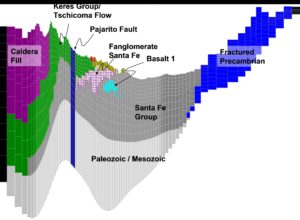Comprehensive Risk Assessment for Los Alamos National Laboratory

HydroAnalysis contributed to a multi-disciplinary team completing a comprehensive analysis of the risk posed by chemicals and radionuclides from the Los Alamos National Laboratory. Our contribution was to the analysis of vadose-zone and groundwater contamination, a critical issue in water-short New Mexico.
The risk assessment project was completed by the Risk Assessment Corporation (RAC) to accomplish “an independent and comprehensive risk assessment for public health and the environment for chemicals and radionuclides associated with Los Alamos National Laboratory (LANL) operations…The primary objectives of this project are to develop:
- a process for extensive stakeholder involvement in the risk assessment and decision-making processes for LANL;
- a methodology to estimate contemporary (current) human health risks and ecological impacts from LANL using available data on chemicals and radionuclides measured in environmental media;
- a methodology to implement a comprehensive risk-informed decision support tool, including a prospective risk and ecological impact assessment and other quantitative and qualitative criteria, to guide long-term management of risks and ecological impacts at LANL; and a consistent approach for efficiently compiling, using, and updating data to support the risk assessment and decision-making processes.”
HydroAnalysis contributed assessments of the groundwater hydrology of the laboratory area, completed a technical review of issues associated with perchlorate, developed a model of regional groundwater flow, and developed a methodology for modeling the vadose zone. The site has several unusual hydrologic features: the water table lies 600 to 1,200 feet below the ground surface; there are numerous perched water zones within the vadose zone; the climate is semi-arid and recharge is variable; and groundwater travel times to receptors may be thousands of years.
HydroAnalysis completed the construction of a groundwater model of the regional aquifer underlying the Los Alamos National Laboratory using MODFLOW and MT3D. The model was designed for use in prediction of transport of contaminants within the water table aquifer. These contaminants included chromium, perchlorate, RDX, and radionuclides. Significant technical issues that were addressed in construction of the model included the appropriate model resolution for efficient transport simulation of a large model domain, representation of geologic units, and calibration of steady-state and transient conditions. An important model objective was to use the transport model predictions for evaluation of future risk due to exposure at potential receptors. Towards that end, the contaminant response at all potentially impacted node locations was evaluated in response to unit mass contaminants loaded at the water table at areas of potential contaminant sources. The unit response results were fitted to analytical functions and stored in a database for evaluation of remedial alternatives and the consequent risk reductions.
The project was completed for the Los Alamos National Laboratory and Colorado State University through a subcontract with Risk Assessment Corporation.